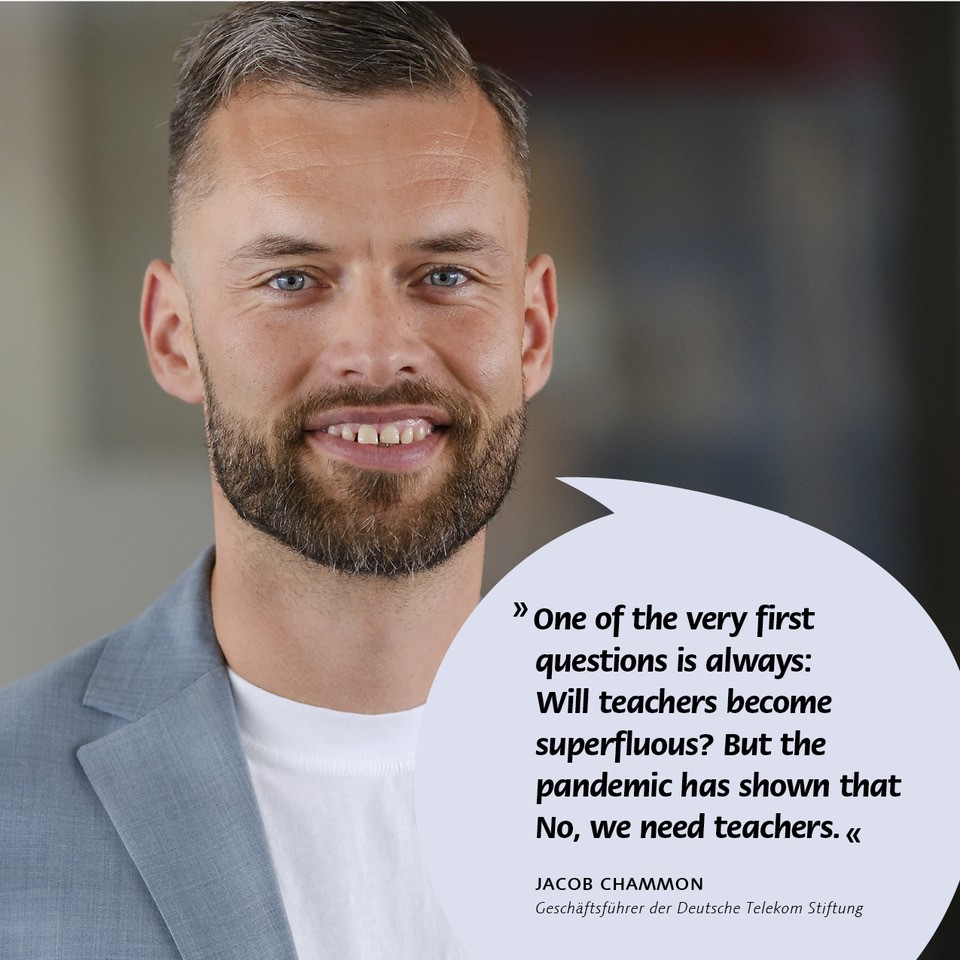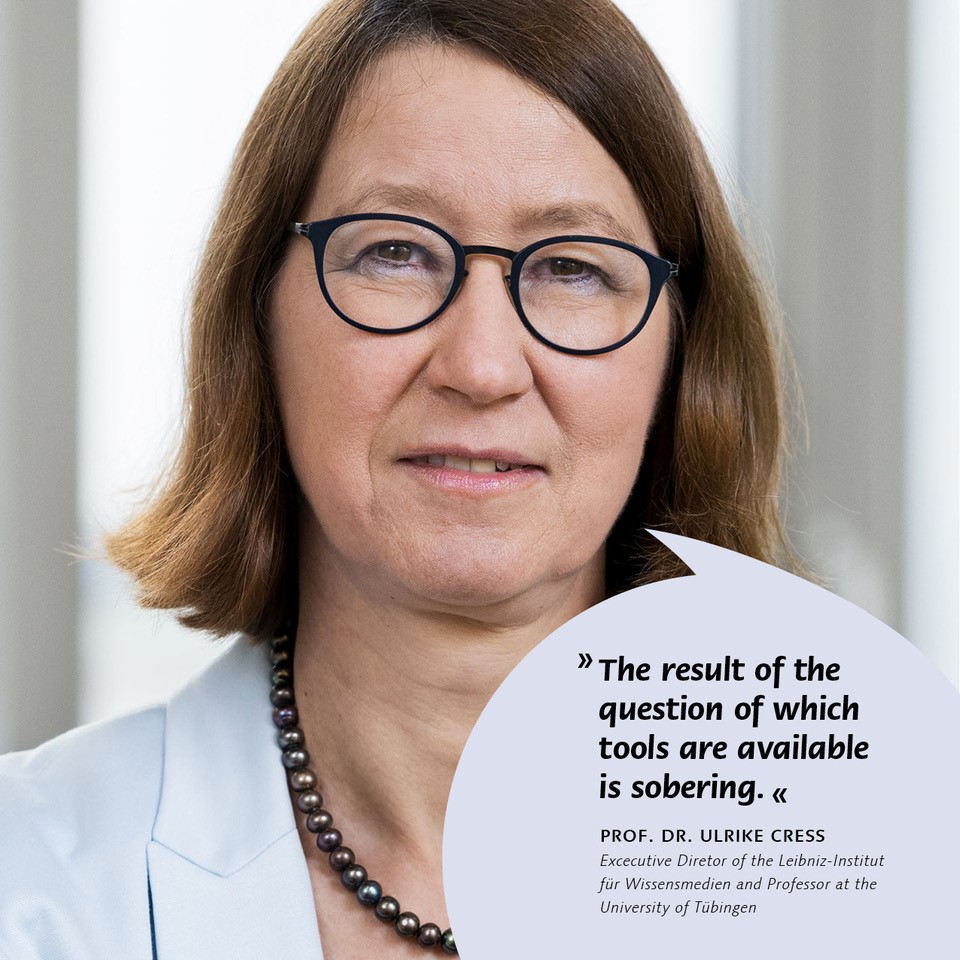There is no turning back
An interview with the IPN's Director Prof. Dr. Olaf Köller, Jacob Chammon and Prof. Dr. Ulrike Cress about AI and the future of teaching and learning
OLAF KÖLLER: Before we look at AI, i.e. artificial intelligence, I would like to talk about how digital education has affected our own lives.
JACOB CHAMMON: I recently met a former colleague in Berlin with whom I was a class teacher in Denmark in 2007. The first smartphones had just come onto the market back then. We were excited to find out how we could use these devices in the classroom. This was before Wi-Fi was available and before all students in Denmark had devices. Learning platforms didn't exist and we tried to find out what we could change with digital technologies in our subject areas. I've been doing that for almost twenty years to this day: finding out how to develop new opportunities in subject teaching and develop them further.
OLAF KÖLLER: Are you a little disappointed now that you're in Germany because it's lagging behind technologically?
JACOB CHAMMON: No. Talking to ninth-grade teenagers, you find out that they all started reading books at school. And now they can hardly imagine picking up a book. We can use many examples from abroad, but of course also from Germany, as good practice. German skepticism and a culture of discussion, e.g. on the subject of data protection, also have their advantages: we avoid repeating mistakes that others have made before us.
ULRIKE CRESS: Knowledge processes always have something to do with media. Text is a knowledge medium, a book is a knowledge medium, as is digital media. Digital media offer many opportunities in that knowledge is already pre-processed, presented or depicted. Cognitive psychology in education has always had a special focus on digital media. Cognitive psychology was already leading the way fifty years ago because it knew how learning functioned well, namely that practice is a very important component, as are feedback and adaptivity, but also the opportunity to construct, communicate and question things together. Media naturally offer excellent opportunities. In practice, digitalization was difficult to get off the ground in Germany back then and was met with a lot of criticism. We are experiencing a different situation now, for example with ChatGPT. Teachers are much more open, even if they were initially skeptical.
OLAF KÖLLER: ChatGPT has been widely accepted in practice. At the IPN, we looked at comparatively traditional forms of mathematics and science teaching for a long time. A focus on the opportunities of digital media in the classroom only came later, probably accelerated by the Covid-19 crisis. We have seen the opportunities that arise when students work with digital units. We can draw conclusions from the data we receive about learners because the computer records what they are doing as to whether they are on the right or wrong track when it comes to working on or solving tasks. We are now focusing on learning analytics. With ChatGPT, for example, educational research is examining its potential. Not only that systems can write texts, but also that systems can automatically evaluate texts written by students and save teachers the work of correcting them. For example, a complex essay can be corrected by the machine in a matter of moments. The machine is not annoyed if the essay is poorly written, so there are no bias effects. How are teachers presently handling this issue?

JACOB CHAMMON: One of the very first questions is always: Will teachers become superfluous? But the pandemic has shown that No, we need teachers, but their role is changing. Let's think about test formats and performance assessments, for example: The student is asked a question and an answer has to be formulated in writing. This task format no longer works with AI. We need to take a serious look at performance reviews. Teachers have realized this. The willingness to change is positive and solution-oriented. Teachers are now mainly asking themselves: How can I give my students the skills they need to assess whether or not the text they produce is good or bad? What criteria can I use to assess such a text? Students still have to learn to write, of course, and will have to continue to do so in the future. But I believe that we also need other language skills, i.e. evaluating, analyzing and reflecting. Then I come back to my favorite topic: conversely, this also means that our examination formats need to have a more reflective, analytical character instead of just reproducing knowledge. In my view, teachers have understood the opportunities that AI offers.
OLAF KÖLLER: AI will change schools and break up routines. As I just said, the classic knowledge task no longer works. You would have to lock students away and deprive them of all digital media. Of course, it causes anxiety and worry when previous routines become obsolete. But there's no going back. Is there actually any empirical evidence for openness?
ULRIKE CRESS: The question is exciting and very ambivalent. On the one hand, we are very critical in Germany. On the other hand, if we look at studies in medicine, for example, patients have a lot of confidence in AI if, for example, they are given the choice of being operated on by a robot or by a doctor. Even if you ask people what they think about a journalistic text being written by AI, it doesn't bother them at all. They are very open to the idea. These tools are trusted to have a higher level of expertise than humans. Nevertheless, it is an important educational task to show realistic expectations of AI: What can it do and what can't it do? Even classmates don't know everything. Some know this and others know that. AI should be viewed by learners in the same differentiated manner as if it were a human being.
JACOB CHAMMON: The question is how we can make AI-based applications that foster learning more widely available in schools.
OLAF KÖLLER: That's an interesting point. But back to the example from medicine: if the added value generated by AI and the relief it brings becomes clear, then it may be accepted. It's the same in schools. Those involved in the day-to-day must be convinced of a significant added value - added value primarily in the form of relief for teachers. Overarching structures need to ensure that changes reach all schools. Model experiments with two or five schools do not lead to comprehensive changes. Ulrike Cress and I are members of the Standing Scientific Commission of the Standing Conference of the Ministers of Education and Cultural Affairs (KMK), which has proposed setting up centers for digital education that bring together academia, companies, state representatives, representatives of school authorities, foundations and textbook publishers to draw up a roadmap for how these changes can be implemented in schools nationwide. The German government has now made money available for so-called digital competence centers. The go-ahead has been given. Now it is important that everyone come together. We need sustainable structures. I've noticed that schools have fallen behind again after the pandemic, whiteboards are no longer being used and tablets are being left in drawers. A good question is: what can we offer schools at the moment?

ULRIKE CRESS: An investigation carried out three years ago compiled a list of the tools available. The result was sobering: around 100 tools were available and the majority of these tools related to learning and practicing, in the sense that children simply receive tasks and feedback. This is part of the so-called after-school market and has nothing to do with school. A small number of tools actually end up in the classroom in the sense of individual learning support. The teacher has an overview of where the class stands and can assign individual tasks in the class. A very small proportion were tools that affect the macro level of the school, e.g. evaluation, data collection, room planning and staff deployment. Nevertheless, these tools also have great potential and are not just about learning, but also about school development. AI offers a great deal of potential that has not yet been fully explored. AI makes teaching and learning better, more interesting and more motivating. We need to focus more on this wide diversity of AI.
OLAF KÖLLER: But one thing is certain: neither the state institutes nor the scientific community will be able to develop them. Resources and the relevant expertise are lacking. Commercial providers have teams of programmers who have ideas for designs, but who also have a very simple perception of school. The applications are often not very complex. It's mainly about practicing. If you look at the math tools, for example, it's almost always just about arithmetic, i.e. working out problems. They rarely covers more complex tasks.
ULRIKE CRESS: So far, virtually everything has been left to the teachers. An interested teacher finds good tools, tries them out and uses them. But it takes a lot of effort. We need to offer more. The federal states need to provide this, as do school education institutions. Teachers cannot be individually responsible.
OLAF KÖLLER: We have criticized the market so far. Are there any examples of good applications that can be used in the classroom?
JACOB CHAMMON: Currently, not many tools can depict complex issues purely digitally. For school processes, which are also social processes, sitting all the children in front of a screen and doing everything digitally is not the way to go. Denmark has materials that cover the topics in three ways: First, AI is used selectively to individualize learning paths. Secondly, they include a physical book, given that there are things that need to be done in social interaction in the classroom, and thirdly, a learning platform for collaborative learning to take place. So, there is the individual, with which things are trained and practiced - that's where AI is used. There is the social aspect, in the classroom without screen time, to work together, discuss and debate things. And there is a collaborative option where students work on things with teachers and receive feedback. This mix is very successful and can serve as a good example.
OLAF KÖLLER: AI allows making many things visible in STEM lessons to make things understandable that would otherwise remain abstract. One last question: can we say that when we talk about digitalization, we automatically mean AI?
ULRIKE CRESS: AI is simply a digital tool that can do a lot. I don't care whether it is AI or not, but whether this tool is technologically up-to-date and can be conducive to learning. Whether it can be applied in practice and then also used remains to be seen. I don’t care if it contains AI or not.
OLAF KÖLLER: That makes sense to me. Thank you very much for this interview!









